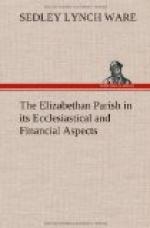Speaking generally (for the jurisdictions called “peculiars” formed exceptions), England was divided for the purposes of local ecclesiastical administration and discipline into archdeaconries, each comprising a varying number of parishes. Twice a year as a rule the archdeacon, or his official in his place, held a visitation or kept a general court (the two terms being synonymous) in the church of some market town—not always the same—of the archdeaconry. The usual times for these visitations were Easter and Michaelmas. The bishops also commonly held visitations in person, or by vicars-general or chancellors, once every third year throughout their dioceses. Yet at the semiannual visitations of the archdeacon as well as at the triennial visitations of the bishop, the mode of procedure, the class of offences, the parish officers summoned, the discipline exercised—all were the same, the bishop’s court being simply substituted for the time being for that of the archdeacon.
There were other visitations: those of the Queen’s High Commissioners, and those of the Metropolitan. There were a very great number of other courts, but for the purposes of the every-day ecclesiastical governance of the parish the two classes of courts or visitations above mentioned are all that need concern us. It is, however, important to state, that while churchwardens and sidemen were compelled to attend the two general courts of the archdeacon (and of course the bishop’s court) and to write out on each occasion formal lists of offenders and offences ("presentments” or “detections”) these parish officers might also at any time make voluntary presentments to the archdeacons. Those functionaries, in fact, seem to have held sittings for the transaction of current business, or of matters which could not be terminated at the visitation, every month, or even every three weeks. Others may have sat (as we should say of a common-law judge) in chambers.[5] Before each general visitation an apparitor or summoner of the court went about and gave warning to the churchwardens of some half-dozen parishes, more or less, to be in attendance with other parish officers on a day fixed in some church centrally located in respect of the parishes selected for that day’s visitation.
The church of each parish was, indeed, not only its place for worship, but also the seat and centre for the transaction of all business concerning the parish. In it, according to law, the minister had to read aloud from time to time articles of inquiry founded on the Queen’s or the diocesan’s injunctions, and to admonish wardens and sidemen to present offences under these articles at the next visitation.[6] In it also he gave monition for the annual choice of collectors for the poor;[7] warning for the yearly perambulation of the parish bounds;[8] and public announcement of the six certain days on which each year every parishioner had to attend in person or send wain and men for the repair of highways.[9] In the




